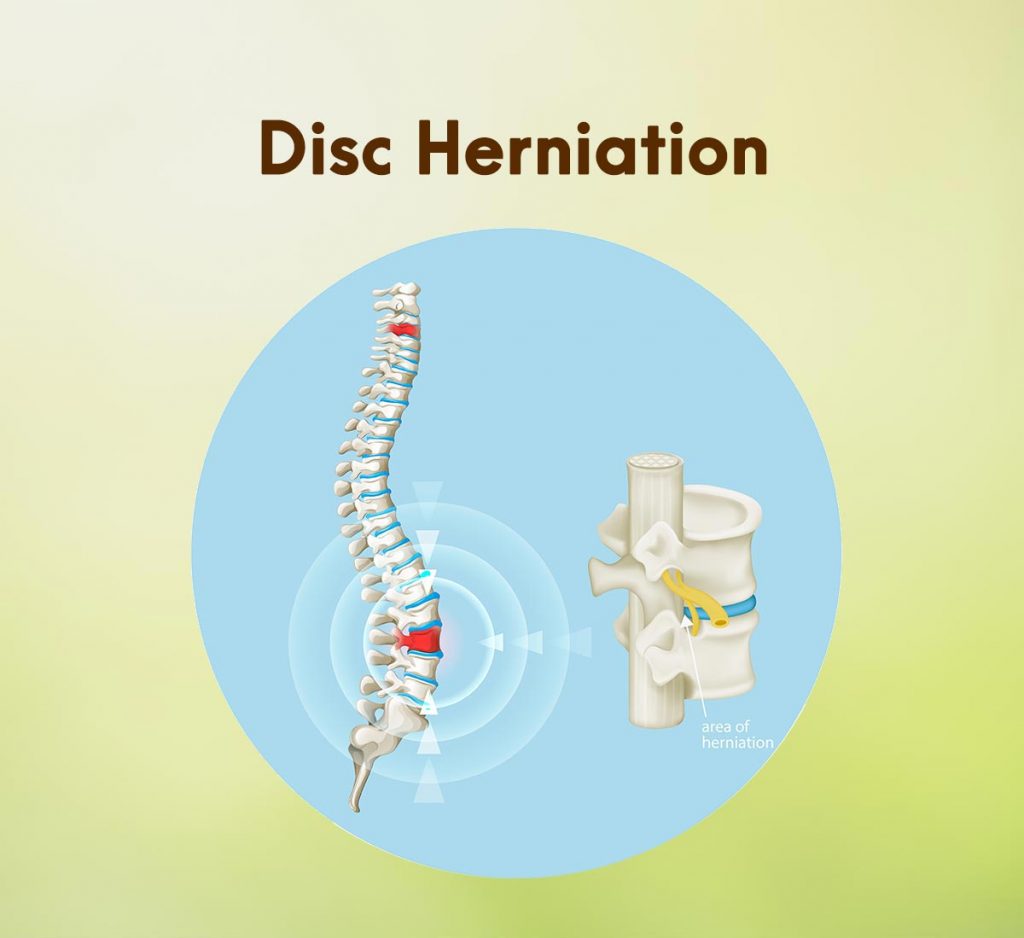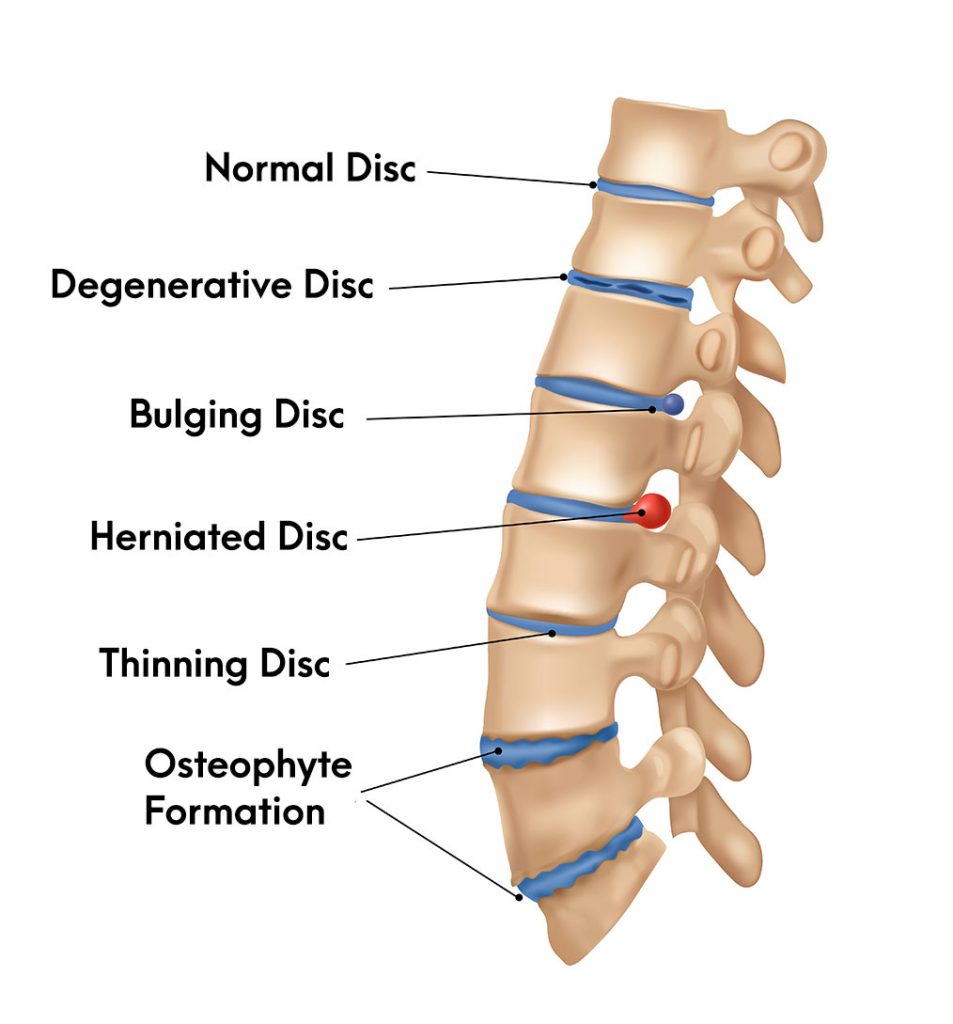Table of Contents
- Spinal Disc Structure
- Types of Disc Herniation
- Bulging Discs
- Different Bulging Locations
- When to See a Doctor
The spine is a remarkably versatile structure consisting of a series of vertebrae or bones, discs separating and cushioning the bones, nerves, soft tissues and the spinal cord. The structure is designed to support the head, provide flexibility for movement and transfer the torso’s weight to the legs. The intervertebral discs comprise approximately 25% of the spinal column.
Sometimes, one or more discs bulge or become herniated. While disc herniation means a spinal disc is compromised, there is a difference between a bulging and a herniated disc, two of the most common medical issues experienced in spinal discs.
Spinal Disc Structure
It is easier to understand a disc bulge vs herniation when familiar with the structure of the spinal disc. There are three main spinal disc components.
- Nuclear pulposus (NP) – a gel-like structure made up of 66-86% water, and the rest consists of mostly collagen
- Annulus fibrosus (AF) – the ring-shaped structure of fibrous connective tissue that surrounds and contains the nuclear pulposus
- Cartilaginous end-plates – cartilage covering the ends of the discs and serving as an interface between the disc and the spine’s bones
Disc herniation is a broad term for any spinal disc where the nucleus pulposus (the soft disc center) is displaced.

Types of Disc Herniation
A bulging disc and a herniated disc are different stages of disc herniation. The two aspects they have in common are that they both concern the spine and are often, but not always, caused by disc degeneration due to aging.
There are four stages of disc herniation.

1. Bulging
The disc connective tissue (ring-shaped structure) bulges beyond the spine’s vertebra, but the gel-like material inside the disc remains intact.
2. Protrusion
A disc protrusion is another situation in which the gel-like disc center remains intact. Still, the width of the base of the protrusion is wider than the diameter of the displaced disc material.
3. Extrusion
In this case, the annulus fibrosis is torn, and the nucleus pulposus (NP), the soft material in the center, extrudes outside it.
4. Sequestration
Disc sequestration occurs when the extruded material breaks off from the material in the center of the disc, causing the nucleus to drip out.
Stages one and two are bulging discs, and stages three and four are herniated discs.
Bulging Discs
Bulging discs can occur differently. For example, a diffuse disc bulge is a generalized condition in which the bulge extends beyond the normal boundaries of the disc’s circumference. It does not always cause pain. However, if the bulging material pinches nerve roots and is near herniating, the pain can become intense.
The symptoms of disc herniation are believed to result from nerve compression due to the bulging of the annulus fibrosis and inflammation. Where the bulging disc occurs determines the symptoms. The spine has three sections: the cervical spine, which is the neck area; the thoracic spine, which is the back’s middle; and the lumbar spine, which is the lower back. Disc herniation can develop in any area of the spine.
A cervical bulging disc may cause tingling or pain in the neck, shoulder, hands, and arms. A lumbar bulging disc may lead to pain in the lower spine, thighs, buttocks, and feet. Other symptoms include muscle weakness and numbness in a part of the body. There are also cases of thoracic disc herniation, but symptoms are rare.
A disc herniation may not cause any pain or mild pain until pressure is increased on a nerve. An annular bulging disc is the term for the condition in which the outer ring of the spinal disc is torn. One of the most common causes is aging. As people age, the spinal discs degenerate, becoming stiffer, drier and weaker. Another common cause is overloading a healthy disc, forcing too much pressure on the disc, leading to a tear in the annulus fibrosis.
Different Bulging Locations
Spinal discs can bulge into different locations.
- Central
- Paracentral
- Foraminal
The central disc bulge is a bulge in the middle of the spine at the disc location. A paracentral disc protrusion is a disc bulge of the spine’s left or right side. The central and paracentral disc bulges press on nerve roots in the spinal canal. The foraminal disc protrusion is a spinal condition in which a disc extends beyond its normal boundaries and presses on the nerve root in the foraminal canal. Foraminal canals are where nerves exit the spine. It can be difficult to detect because the bulge is hidden in the nerve canal.
When to See a Doctor
A doctor’s physical exam and medical tests, such as a spine X-ray or MRI, can diagnose disc herniation. Some bulging and herniated discs heal on their own with rest and anti-inflammatory medications. More severe cases may require surgery. It is important to see a doctor when experiencing symptoms like back pain, numbness in a limb, or other symptoms. The sooner a doctor can identify the condition, the sooner a treatment plan can start.
Sources
- https://www.ncbi.nlm.nih.gov/books/NBK525969/
- https://pubmed.ncbi.nlm.nih.gov/29262063
- https://www.ncbi.nlm.nih.gov/books/NBK470583/
- https://www.ncbi.nlm.nih.gov/books/NBK546618/
- https://www.ncbi.nlm.nih.gov/pmc/articles/PMC8326068/
- https://www.ncbi.nlm.nih.gov/books/NBK560878/
- https://www.ncbi.nlm.nih.gov/pmc/articles/PMC8907636/
- https://radiopaedia.org/articles/foraminal-disc-protrusion?lang=us